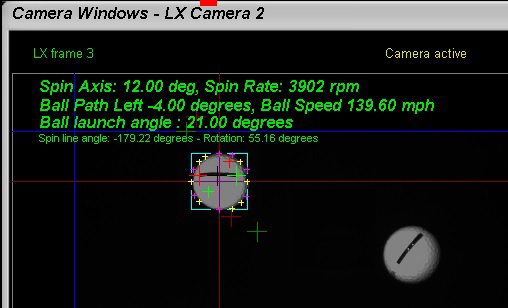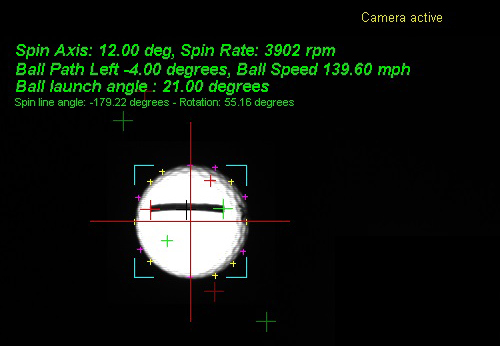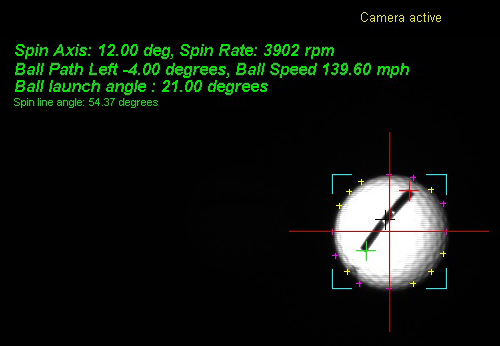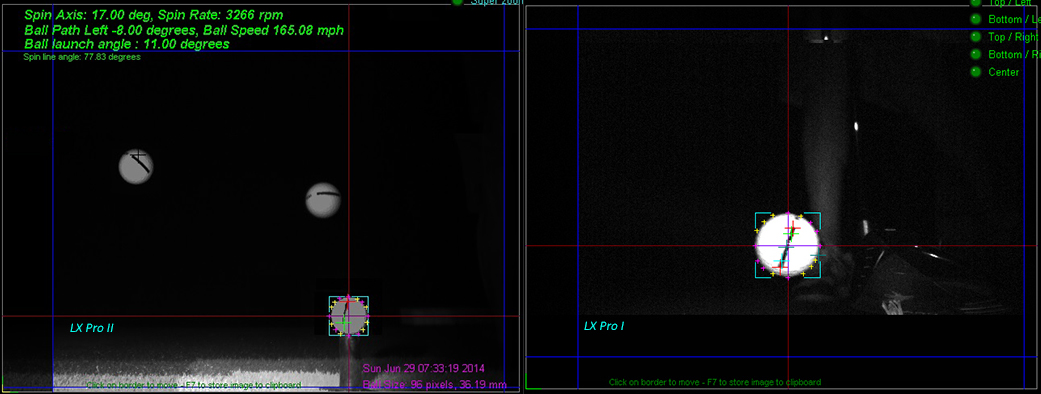

LX Pro II - test result images
![]()
! This page still under construction !

A composite of frames 2 and 3 of the ball in flight.
 -
-
Left: frame 3. Right: frame 2.
![]()
LX Pro II compared to LX Pro I

As LX Pro II is placed further ahead, the player's club and legs are no longer in the camera's FOV, however, the ball images are much smaller.
Pros and Cons of the LX Pro II compared with the LX Pro I
The LX Pro II has a number of advantages over the LX Pro I but also has some disadvantages. Below is a comparison:
LX Pro II advantages over LX Pro I
1. Ability to be used for both left and right handed players without having to move the unit.
2. The player is not in the FOV of the cameras so image processing errors caused by clubs and players legs or feet in the images are avoided.
LX Pro II disadvantages over LX Pro I
1. The LX Pro II is much further away from the player and thus the images of the ball are much smaller and thus image processing won't be quite as accurate.
Zoom lenses cannot be used to compensate for this as the ball's flight range is far greater. i.e. the ball has traveled higher and further and the use of zoom lenses would mean that high launch angle shots won't be in the FOV of the cameras.
2. The LX Pro II uses2 IR Xenon flash units that will eventually burn out and/or deteriorate and require replacing ($50 each). The Xenon flash manufactures claim the units are good for 500,000 flashes - which seems like a lot a shots if only one flash is used for each shot - but testing is showing that for every shot there are a number of inadvertent flashes caused by players walking around the enclosure to retrieve balls and/or ball's rolling back from the impact screen.
I'm adding an additional circuit to the system board that will alleviate this issue to a great extent though. It consists of wiring the Mic trigger output to a logic gate that blocks the signal to the flash and will only unblock it for a second or so when a club / ball impact sound is detected. This works great as long as there is a distinct audible club/ball impact sound which is normally the case with full and half shots but this is not the case when putting or chipping.
In this case the signal must not be blocked. Fortunately I built in a putting and chipping mode logic signal into the circuit and this can be used to unblock the flash signal when in this mode. Of course that means that when in putting mode the flash will still get fired every time a player walks in front of the unit but at least we have eliminated the majority of inadvertent flashes.
3. Other smaller disadvantages are:
1. Surprising as it may seem, the LX Pro II is more likely to get hit by stray balls then the PX Pro I even though the LX Pro I is only 14 inches away from the ball and the LX Pro II is some 3 feet forward and 2 feet off to the side. This is because the LX Pro II is more in the line of fire whereas the LX Pro I is just placed off to the side.
2. The LX Pro II casing is a 3rd larger than the LX Pro I.
3. Due to it's greater assembly and component complexity, the LX Pro II is more expensive.
![]()